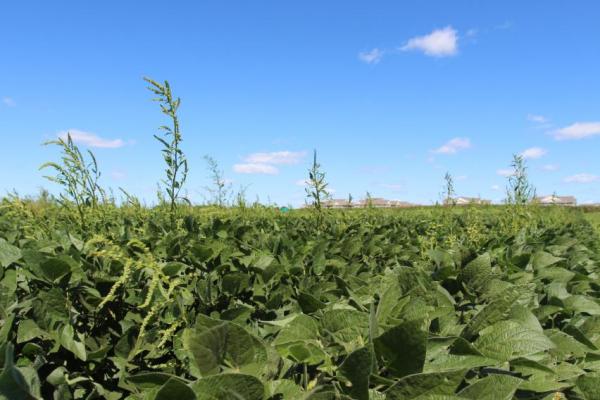February 7, 2019

By Bob Hartzler and Meaghan Anderson, Iowa State University
Although there are many ways weeds escape control in crop fields, one of the leading causes of waterhemp control failures is emergence of plants following postemergence herbicide (POST) treatments. Waterhemp requires more than twice as many growing degree days to reach 50% emergence as giant foxtail or velvetleaf (Figure 1), resulting in much of the population emerging after mid-June.

Figure 1. Relationship between growing degree days and emergence of four weeds. Werle, Sandell, Buhler, Hartzler and Lindquist. 2014. Weed Sci. 62:267-279.
The layered residual system is one of the best ways to reduce late-season waterhemp escapes in soybean. It involves a split application of herbicides with residual activity – the first application is made at or near planting, and then additional residual is included with the POST application (Figure 2). The additional residual herbicide extends activity later into the season than a single application, and is especially beneficial in years with heavy rains following planting.

Figure 2. The layered residual approach to full-season control.
Numerous products are available for the first application (Table 1), but it is important to select a product that is highly effective on waterhemp. For fields with heavy waterhemp pressure, the Group 14 and 15 herbicides will provide the most consistent control. Group 15 herbicides are the only products with sufficient residual activity to be included with the POST application.

Since the goal is to extend control later into the season than typically achieved with preemergence products, the layered residual approach requires the maximum labeled rate for the soil type. Typically 60 to 70% of the preemergence herbicide is applied at planting, and the remainder in the second application. The University of Minnesota has published information comparing the effectiveness of several layered programs.
Timing of the second application is critical for consistent results, this application should be made at least a week earlier than the typical timing for POST applications. Rather than delaying the application to allow more weeds to emerge, the second application should be made while the initial preemergence application is still active. Three weeks after planting is a good timeframe for the second application in most situations. Even if few weeds are present at the time of this application it is critical to include an effective POST product to control any emerged weeds.
Layered residuals help reduce selection pressure placed on POST products by reducing the percentage of the weed population controlled by the POST herbicide. This transfers the risk to the residual herbicide, so layered residuals are not a long-term solution to manage herbicide resistance. If the strategy can result in cleaner fields than currently achieved, the reduction in the seedbank will reduce the threat of new resistances. Not every field may require this aggressive approach to manage weed problems, but fields with consistent late-season waterhemp problems will likely benefit from a full rate of residual split between the PRE and POST applications.
Source: Iowa State University, which is solely responsible for the information provided and is wholly owned by the source. Informa Business Media and all its subsidiaries are not responsible for any of the content contained in this information asset.
You May Also Like




